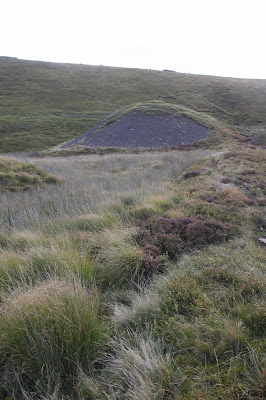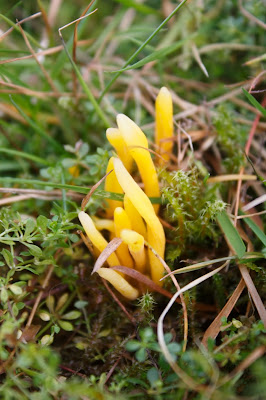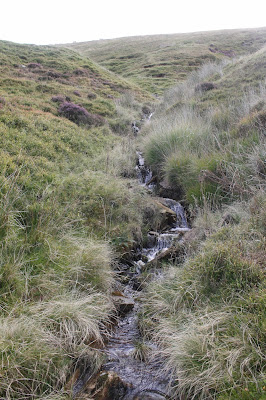My copy of Martin Haigh's The Evolution of Slopes on Artificial Landforms, Blaenavon. UK (1978) claims this tip to be the oldest in the Blaenavon industrial landscape complex. Sitting in Mynydd Coity's ffridd habitat and overlooking the expansive Waunafon bog the tip with its large' black eye' of unvegetated coal spoil purports to originate from early Victorian times. Having promised myself a closer look I finally made the effort late Friday afternoon, scaling a hillside where nowadays only ponies and bikers dare venture.
It was some trek, through tussockly stands of molina that hid drainage ditches and rocks I came across long forgotten features of man's efforts to conquer nature. A pair of railway sleepers bridged a drainage ditch leading to a large rusty lichen encrusted water value that in turn revealed a small reservoir of open water with extensive margins of sphagnum moss. This legacy of water management paraphernalia seems to be off the radar of those who champion cultural both and natural landscapes.
Where gazing animals are able to browse there was dung with associated dung fungi and where the grass was short grassland fungi such as the golden spindles fungi Clavulinopsis fusiformis could be found. I took advantage of my elevated position to view Waunafon bog from the west and in doing so noticed a couple of distant walkers seemingly collecting magic mushrooms and a stonechat moving between thistle tops.
Having reached the tip it was something of an anti-climax. Not sure what I expected but the oldest tip in the book was much like all the other tips I've frequented doing my time as an advocate of post in industrial landscapes. Nonetheless the extent of mature dwarf shrub heath that clothed most of the tip hinted at its elderly nature. Why the eastern flank remains devoid of any green biomass is conjecture. Could be the angle of repose or a hostile chemical composition? A fast running stream that emerged from the hillside cut its route close to northern side suggesting the tip was deposited almost slap bang on top of this running water feature. Another example of the lack of appreciation surrounding the dynamics of natural resources displayed by our industrial forefathers.
 |
| The tip! |
 |
| Dung fungi |
 |
| Golden spindles fungi |
 |
| Stream to side of tip |
 |
| Sleepers across a ditch |
 |
| Man made pond with draw down pipe. |